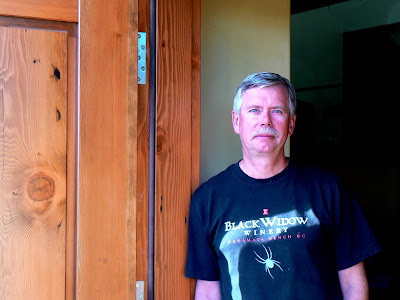Bottega Wine Studio is the among the new labels to emerge
this year in the Okanagan, a virtual winery launched by winemaker Daniel Bontorin
and his partner, Kristine Little.
For several years, they have made rosé wines under the Seven
Directions label. That brand remains but folded under the Bottega umbrella.
Bottega is Italian for the studio of a master artist, which
signals Daniel’s winemaking ambitions.
He launched Seven Directions in the 2012 vintage to produce
just rosé.
“We started out as a virtual winery with no brick and
mortar building,” he says. “We considered doing other reds and whites under the
Seven Directions brand. But we were known for being the only rosé specialist in
Canada, and we wanted to keep it that way. From day one we talked about making
single vineyard rosés exclusively. Rosé has always been one of my favourite
wines to make. People got to know Seven Directions only as rosé.”
The Bottega brand has been created for other white and
red table wines, to avoid diluting the Seven Directions image.
Daniel’s rosé-making pedigree goes back to the 2005
vintage when he made Vaïla, the outstanding rosé at Le Vieux Pin. That wine,
along with rosé from JoieFarm Winery, started the renewed interest in a wine
style made embraced by the majority of wineries.
Born in Surrey in 1976, Daniel
kicked around at several jobs in the Okanagan, including importing motorcycle
parts, until 2000 when he recognized that the real future was in wine. After
courses at Okanagan University College ,
he worked in the cellars at several wineries including Fairview Cellars,
Domaine Combret, Hillside and Hester Creek.
Then he did a vintage in northern Italy
He returned to join
LVP for the 2005 vintage. Subsequently, he has become a successful consultant. His
major clients currently include Volcanic Hills (under whose license Bottega and
Seven Directions are released) and Bordertown Vineyards.
“Bottega isn’t just a label,” Daniel says. “I am looking to
make higher end wines from both red and white varieties. I am trying to find
the best grapes and make the best representation of those varieties in the
styles that I like.”
The varieties currently released or maturing in the cellar
include Merlot, Cabernet Franc and Viognier. “We started out with Viognier
because my wife likes Viognier,” Daniel says. “And Merlot is one of the
varieties I have done very well with.”
He and Kristine have a long-term plan to turn Bottega
into a land-based winery. “My vision is, once we have our own place, is to have
a custom crush place for other winemakers to come in and make their brands,
similar to how we started out.”
Here are notes on the current releases.
Seven Directions
Pinot Noir Rosé Tractor and Vines
Vineyard 2017 ($22.90 for 270 cases). The wine presents in the glass with
the fashionably pale hue of a Provence rosé. It begins with aromas of
strawberries, rhubarb and a medley of tropical fruits, all of which is echoed
on the juicy palate. A hint of residual sugar lifts the aromas and flavours and
adds weight. 91.
Seven Directions
Cabernet Franc Rosé Fruitvale Ridge Vineyard 2017 ($20 for 444 cases). The
wine displays a delicate pink hue and has aromas of wild strawberries and
rhubarb. There is considerably more power on the palate than the hue suggests,
with flavours that echo the aroma. The juicy, creamy texture ends with a dry finish.
90.
Bottega Viognier 2016
($23.90 for 1,580 bottles). This wine begins with fragrant floral aromas that
evolve in the glass to show citrus and apricot. On the palate, the wine has
flavours of white peach, pear and apricot. Good acidity keeps the wine vibrant
with a crisp finish. 91.
Bottega Merlot 2015
($55 for 600 bottles). This is something of a tour de force – a bold, rich wine
with great intensity. It begins with aromas of cassis, black cherry and plum
with a hint of liquorice. On the palate, there are flavours of plum and fig
mingled with a medley of spiced dark fruit. This is an age-worthy wine. 92-94.



































